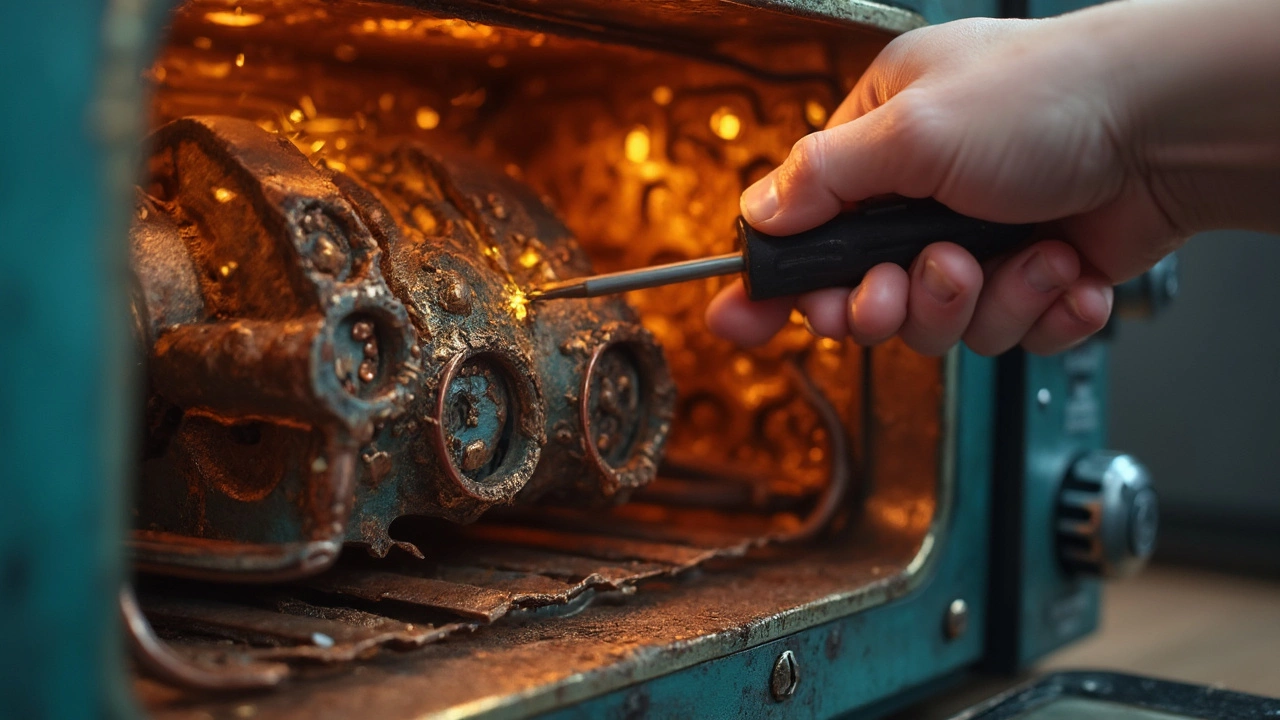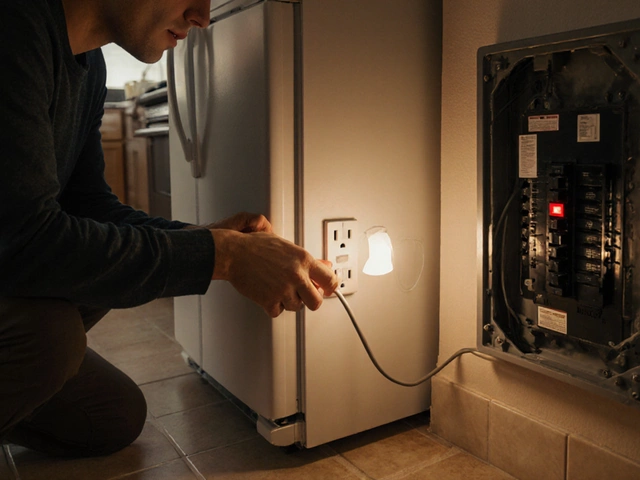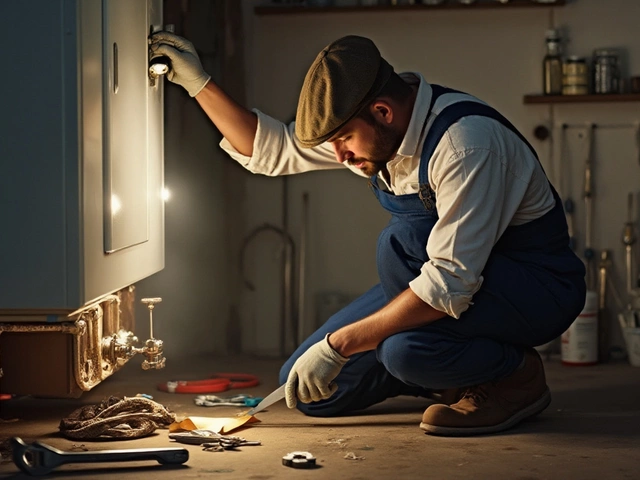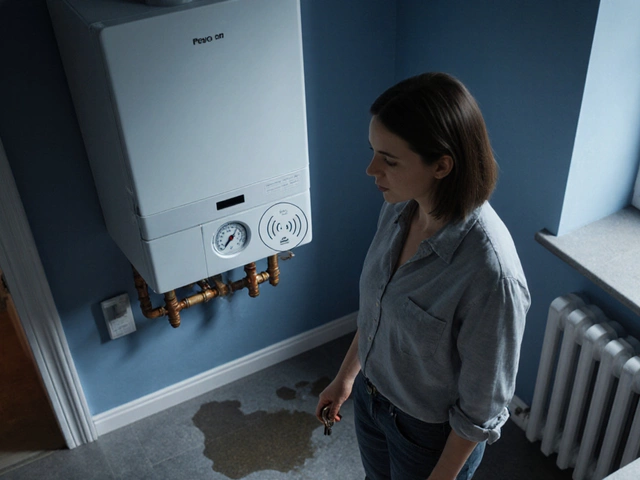Your electric oven is the unsung hero of the kitchen, making everything from your midweek roast to those Sunday afternoon cookies. But then it happens—it decides not to work. Annoying, right? Before you resort to takeout for every meal, let's walk through what's going on.
First off, check the basics. Is it plugged in? Sounds obvious, but you wouldn't believe how many times it's just a loose plug. Look at your breaker box; a tripped circuit could be just as guilty.
Now, if that's not the issue, you could be dealing with a faulty heating element. They're kind of like light bulbs—when they go, they go. Spotting this is easy: turn the oven to a bake or broil setting and see if each element glows. If one doesn't, well, there's your culprit.
And hey, sometimes it's as simple as a dud control setting. We’ve all been tricked by those sneaky dials and buttons. Double-check the settings to make sure they’re on point. Set it a hundred times? Maybe there's a bigger issue at hand.
Armed with these checks, you're ready to tackle the problem or know when to get some professional help. Nothing worse than staring at an oven face-off when your chicken's still in the freezer!
Common Causes of Failure
Alright, let's break down why your electric oven might be on strike. It's not just one issue; there could be multiple troublemakers lurking in there.
Faulty Heating Elements
These things are the heart and soul of your oven. They do the heavy lifting by actually heating your food. If you notice uneven cooking or if one element isn’t heating up, it might be time for a replacement. Want a quick check? Turn the oven on and peek inside. The element should glow red when it's working properly.
Blown Fuses or Tripped Breakers
Think of fuses and breakers as your oven’s bodyguards, preventing dangerous power overloads. Sometimes, they go overboard and cut off power totally. Head to your electrical panel and make sure nothing’s tripped. Is it persistent? The problem could be in the wiring.
Burnt Out Wiring
Wiring sounds mundane, but it’s crucial. If wires are burnt or loose, your oven's power flow is messed up. Without the right flow, your oven's parts won't function properly.
Malfunctioning Thermostat
Ever noticed your oven feels too hot or not hot enough? The thermostat could be acting up. It’s supposed to maintain temperature with precision. Faulty thermostats can wreak havoc, making your foods undercooked or burnt.
Electrical Connection Issues
Your oven might look sturdy, but it's sensitive to power issues. Check that it's plugged in firmly and inspect connections for any wear or damage.
| Common Issue | Percentage of Occurrence |
|---|---|
| Faulty Heating Elements | 45% |
| Blown Fuses | 30% |
| Thermostat Failure | 15% |
| Electrical Connection | 10% |
Tackling these common causes gives you a head start on solving your oven woes. Sort through the list, and you might just find what’s eating at your trusty kitchen appliance.
Troubleshooting Tips
So, you've done the basics and your electric oven, the staple of your kitchen, is still giving you grief. Time to roll up your sleeves for some DIY oven repair. Let's start with the heating elements.
Testing the Heating Elements
If your oven isn't hitting those toasty temps, the elements might be to blame. Here is a step-by-step guide to check them out:
- Turn off and unplug your oven. Safety first, folks!
- Open the oven and locate the heating elements—one at the top and another at the bottom.
- Visually inspect for any signs of wear, like breaks or blistered patches.
- Use a multimeter to check the continuity. A working element should show a complete circuit.
If the multimeter reading is off or zero, it's new element time.
Checking the Temperature Sensor
The oven might not be heating properly if the temperature sensor is shot. Find this little gadget inside your oven, usually attached to the back wall. Test its resistance with a multimeter:
- Unplug the oven and remove the sensor.
- Set the multimeter to the ohms setting; a working sensor reads about 1100 ohms at room temperature.
Any wild readings here? Time to swap it out with a new one.
According to appliance expert John Rogers of HomeFixItRight, "The majority of oven issues can be resolved with a little patience and a multimeter. It's amazing what you can do when you understand the basics."
Examining the Control Board
If your oven’s digital features aren't lighting up or acting like they're from a sci-fi movie, it might be the control board.
- Remove the back panel of the oven to access the board.
- Look for any obvious signs of damage like burn marks or melted plastic.
Replacing a control board isn't for everyone, so if this feels beyond a Saturday afternoon project, it might be time to call in a pro.
By going through these steps, you'll be closer to figuring out why your oven has taken a break from its regular baking duties. Remember, the more familiar you are with your oven, the less stressed you'll be when it decides to glitch.

When to Call a Professional
So, you've fiddled with the knobs, checked the plugs, and peeked at the heating elements, but your oven's still not behaving. This is when you might want to throw in the towel and get some professional help. Here's how to know when it's time to call in the cavalry.
Electrical Issues
If there's a strong burning smell or you spot sparks, turn off the oven and unplug it immediately. These signs of electrical issues are big red flags that need a professional’s expertise. Electric ovens require high voltage, and playing with wiring isn’t something to do solo unless you're a trained electrician.
Complex Repairs
Some repairs are just too complex to tackle without the right skills and tools. Replacing a thermostat or fixing a complex control panel problem can be tricky and usually costs more if done incorrectly. If the oven isn't heating evenly or at all, even after checking the elements, it might be a thermostat issue.
Persistent Problems
Have you fixed it only to find the issue crops up again? That’s not only irritating but potentially dangerous. Recurring problems could mean there’s a deeper issue affecting your electric oven that needs a professional diagnosis.
| Common Problems | Professional Needed? |
|---|---|
| Burnt smell / sparks | Definitely! |
| Uneven heating | Usually |
| Control panel issues | Most likely |
Age of the Appliance
If your electric oven is over a decade old, and you're constantly dealing with issues, it might be time for a replacement. While calling a professional for advice on whether to repair or replace is smart, be prepared that you might hear it's time to shop for a new one.
Overall, if after all your checks and small fixes, you feel even slightly unsure, it's better to consult a professional. It might cost a bit more upfront, but messing with electrics can lead to bigger bills—or worse—if not done correctly.
Simple Maintenance Tips
Keeping your electric oven in good shape doesn’t have to be complicated. A little regular maintenance goes a long way in preventing those unexpected breakdowns. Here are some easy tips to keep your oven cooking.
Regular Cleaning
Start with the basics—cleaning. Ovens should be cleaned every three months or so to prevent buildup of grease and grime. For safety, always unplug your appliance before you start any cleaning.
- Remove oven racks and soak them in warm soapy water.
- Use a mixture of baking soda and water as a natural cleaner for the interior. Apply it, leave it overnight, and wipe it down the next day.
- For stubborn spots, a little vinegar can work wonders!
Check the Door Seal
If your food's taking forever to cook, the door seal might be the problem—losing heat means losing energy efficiency. Simply open up the oven and inspect the gasket around the door. If it's cracked or brittle, consider replacing it.
Inspect Heating Elements
Give those heating elements a visual check every now and then. They should glow red-orange when they're working. If they have dark spots or don't light up uniformly, they might need a swap. Remember, don't touch them when they're on!
Look at the Control Panel
Those dials and buttons do a lot more work than you think. Be sure to check they’re not loose or sticky. A cloth dampened with mild detergent can keep them clean and functional.
Mind the Electrical Connections
While you're at it, ensure that the plugin and the cord are not frayed or damaged. Tighten any loose connections to prevent any fire hazards. But hey, if something looks seriously wrong, let a professional handle it!
Maintaining your oven is not just about keeping it functional but about ensuring it lasts longer. Consistent care will save you from frequent repair bills and keep your food coming out perfect, every time!







